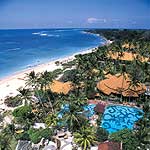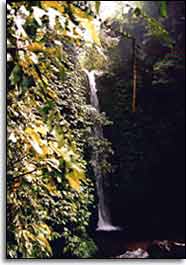Sanur, Bali
 Sanur is the first area in Bali to have resort hotels.It's located 20 minutes from Kuta along the Bypass. Sanur is a low key area of mid range and higher level hotels.
Sanur is the first area in Bali to have resort hotels.It's located 20 minutes from Kuta along the Bypass. Sanur is a low key area of mid range and higher level hotels.As the first area in Bali to have resort hotels, Sanur is where Bali's first luxury beach hotel was built over 30 years ago, and has since been the spot for luxurious seaside accommodation. Conveniently located near Denpasar on the main road leading to the east, Sanur is not nearly as frenetic as Kuta, nor as well-mannered as Nusa Dua.
The main attraction here is the white sand beach bordering a reef-sheltered lagoon. The beach stretches south from the The Grand Bali Beach Hotel and ends up in the mangrove marshes opposite Serangan Island. Due to the protection of the lagoon, this beach is one of the safest on the island, and thus perfect for families.
Sanur can be divided into several sub-areas:
_The Grand Bali Beach Hotel area.
West and south of the hotel, at the point where the black and the white sand beaches meet. This northern section of Sanur is popular with local crowds.
_Sindhu is east
of JI. Bypass Ngurah Rai, and south of JI. Segara Ayu, extending south to the first stretch of JI. Danau Tamblingan. This area is classier, with good hotels on the beach, night and art markets, and good restaurants.
_Batujimbar,
further south, has few hotels, but is the location of expatriate and Indonesian jet set society mansions. Exclusive beaches are reached via small lanes.
Semawang stretches south from the Bali Hyatt Hotel to the Sanur Beach Hotel and beyond. It houses both the priciest hotels and restaurants, as well as the red light district.
Get to Sanur from the airport by taxi. Tickets available at the airport taxi co-op counter outside customs, near "left luggage". The set fare is Rp. 35,000 to Sanur.
Within Sanur either rent a car or catch one of the many public bemos that ply JI. Danau Tamblingan for Rp1,000. These can be chartered for short hops around Sanur ($l-$2), and for trips to Denpasar or Kuta ($2-$4). Bargain hard. The terminal of the Praja Taxi company is in Sanur, Phone 289191, 289090. Bali Taxi is in Jimbaran, Phone 701111, 701621, 701633. Pan Wirthi Taxi is in Kuta, Phone 723355, 723388, 723952.
Biking around Sanur is also fun. At the Tri Dewi Art shop, JI. Danau Tamblingan 48, in Semawang, you can rent a bike for Rp15,000/ day; try bargaining. The bicycles aren't the greatest. It may be wise to pay more by renting through your hotel.
Sanur is an ideal base for trips to Bali's rice growing heartland and the mountain areas. Rent a self-drive car or a minibus with driver on a daily basis. There are car rental companies on JI. Bypass Ngurah Rai and on JI. Danau Tamblingan. Cars and minibuses for hire are found outside all major hotels, or go through one of many car rental companies.
The most reputable self-drive rental agencies are Avis, which has desks at Jimbaran, in the Nusa Dua Beach Hotel and the Sheraton Lagoon Nusa Dua; Bali Car Rental on JI. Bypass Ngurah Rai; and Toyota Rent a Car at the airport, Jimbaran, on JI. Raya Airport 99X, in the Bali Padma Hotel in Legian, and Kartika Plaza Hotel in Tuban.
A day-trip in a minibus with a multilingual guide costs around $25, including gas, depending on the itinerary. Group tours cost as little as $10-$15 for the main tourist destinations. Contact Pacto, Tunas Indonesia, Mekar Wisata, or your hotel travel agent.
Private Houses. An alternative to standard accommodations is to rent luxury bungalows owned by affluent foreigners. These can work out relatively reasonably, if food and drink are bought at supermarket prices. Prices range from $250/day for a villa for two, to $1,500/day for a two-hectare beachfront estate with 14 staff, an archery range and use of a game fishing boat
To look place for eating out in Sanur is not a big problem. The Bali Hyatt, The Grand Bali Beach and Sanur Beach hotels have a wide variety of restaurants, buffets, and coffee shops. The food is mostly European, but they also offer Indonesian, Chinese and Japanese cuisine. Most of them offer a greater variety of food in a broad price range. Most close at 10 pm. The cheapest and most colorful food spat at night is the Sanur Night Market, located in the Art Market. The food is spicy, but nothing is cheaper; you can get a nasi campur for Rp3,000-Rp3,500.
For cheap, but better quality local food-the kind of place where your guides prefer to eat go to the street restaurants in Sindhu, on Jl. Bypass Ngurah Rai between JI. Segara Ayu and JI. Sindhu. Try Haji Imran's (sate), Cak Muk or Depot Robby's (Chinese).
Warung Jawa Barat, on the corner of JI. Mertasari and JI. Kesumasari in Semawang, has a range of Sundanese food from Western Java, such as grilled fish, karedok (mixed raw vegetables in coconut sauce) or sate. Prices are good: between $1-$1.50.
Read more....



















